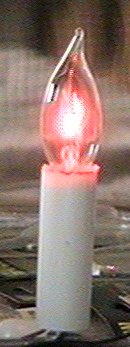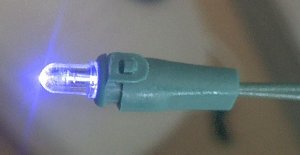Available lighting types
This page lists the various forms of lighting you can use for your projects.
Except where noted, most of the lighting is suited for flashing with a
microcontroller. Today, there are many choices in the kind of lighting
you can use, and there are more types suited for battery power than ever
before.
Neon and argon lamps
 Over
100 years old, this is one of the oldest forms of lighting. They are made
out of glass envelopes filled with neon or argon gas. Neon glows orange.
That's the only color you can get out of it. Argon, on the other hand,
produces ultraviolet light. That means that the glass of the lamp can be
coated with a phosphor coating, and just about any color of the rainbow
can be produced.
Over
100 years old, this is one of the oldest forms of lighting. They are made
out of glass envelopes filled with neon or argon gas. Neon glows orange.
That's the only color you can get out of it. Argon, on the other hand,
produces ultraviolet light. That means that the glass of the lamp can be
coated with a phosphor coating, and just about any color of the rainbow
can be produced.
These lamps come in two forms, the type used in signs, which generally
require a 15,000 Volt power supply, and the indicator lamp size, which run on 120 Volts with the proper
dropping resistor. It's these smaller indicator lamps that are of most
interest here for several reasons, especially the NE-2 type (right), that
can be mounted in miniature Christmas light sockets. A conventional series
light string can be rewired in parallel with the proper series resistor
(usually 100K) for each lamp. Besides the orange neon type, you can also
get these small lamps in green. These are argon lamps with a green phosphor
coating.
supply, and the indicator lamp size, which run on 120 Volts with the proper
dropping resistor. It's these smaller indicator lamps that are of most
interest here for several reasons, especially the NE-2 type (right), that
can be mounted in miniature Christmas light sockets. A conventional series
light string can be rewired in parallel with the proper series resistor
(usually 100K) for each lamp. Besides the orange neon type, you can also
get these small lamps in green. These are argon lamps with a green phosphor
coating.
Another form of neon lamp is the so-called flicker flame lamp (left).
They usually screw into candelabra sockets and are designed to run on 120
Volts without an external resistor. These lamps actually produce what looks
like a flickering flame.
Electro luminescent lighting
This type of lighting has also been around for quite some time, but
a new form of it, often called "neon" has made a recent appearance. Actually,
it has nothing to do with either neon or argon gas. The reason it's called
neon is because it is a tube (in this case, plastic rather than glass)
that you could shape into letters, just like a neon or argon sign. The
electro luminescent wire is built much like coax cable. It has an inner
conductor that has a phosphor coating. Around this are wrapped two outer
conductors. Finally, there are two outer plastic coatings that cover all
of this.
The more traditional kind of electro luminescent lighting is in the
form of a plastic sheet, often called an electro luminescent panel.
This is the kind used for those green flat night lights, clock backlights
and recently, animated gadgets you can wear.
Regardless of it's form, the principle of operation is the same. It
consists of a capacitor with a phosphor sandwiched in between the two electrical
connections. When about 90 Volts AC is applied to these connections, it
causes the phosphor to glow. This type of lighting can be powered using
batteries and a small inverter. I tested a model called NeonWires and it
only pulled 60mA from a 12 Volt supply, not bad for a six foot glowing
wire. Here are some web sites about all this.
Light emitting diodes
 Although
they came into existence in 1962, it wasn't until 1969 anyone outside of
a laboratory could obtain one. Even then, the only color you could get
was red. Next came green and yellow. It took a long time after that for
any other colors to appear. Now you can get them in any color of the rainbow,
including white, and get this, you can even get ultraviolet ones (left).
Like the neon indicator lights, LEDs can be mounted in miniature Christmas
light sockets and wired in parallel with a 470 Ohm resistor for 12 Volt
operation. This makes them handy for use in light chaser strings. LED's
generally pull 20mA per lamp.
Although
they came into existence in 1962, it wasn't until 1969 anyone outside of
a laboratory could obtain one. Even then, the only color you could get
was red. Next came green and yellow. It took a long time after that for
any other colors to appear. Now you can get them in any color of the rainbow,
including white, and get this, you can even get ultraviolet ones (left).
Like the neon indicator lights, LEDs can be mounted in miniature Christmas
light sockets and wired in parallel with a 470 Ohm resistor for 12 Volt
operation. This makes them handy for use in light chaser strings. LED's
generally pull 20mA per lamp.
LEDs are highly suited for battery operation because no inverter is
needed to step up the voltage. They also have the longest life of any of
the above mentioned light sources, usually 100,000 hours. Here are some
related web sites:
Cold cathode fluorescent lamps
Hot cathode fluorescent lamps are the conventional kind. The hot
means that the filaments at the end of the lamps are heated. This is not
the case with cold cathode fluorescent lamps, which tend to be much smaller
than conventional fluorescent lamps (usually under a foot in length and
3mm in diameter). These lamps come in all different colors (including ultraviolet)
and are usually powered by 12 volt inverters rather than with conventional
ballasts. They draw much more current (usually at least 200mA) than the
other lighting mentioned above, which means your lighting controller will
have to have some pretty hefty transistors to switch the load for these
lamps. For this reason, I prefer the electro luminescent wire, although
the cold cathode fluorescents do produce a much brighter light. Now for
some web sites dealing with this type of lighting:
Finally, I'll have to say that there's more than one kind of lighting that
can be a groove, so experiment around.
Copyright © 2002, Colin Pringle (colin@wild-bohemian.com)
The mail link automatically fills in the subject field so I will know
which page you're commenting on.
lighting.htm
 Over
100 years old, this is one of the oldest forms of lighting. They are made
out of glass envelopes filled with neon or argon gas. Neon glows orange.
That's the only color you can get out of it. Argon, on the other hand,
produces ultraviolet light. That means that the glass of the lamp can be
coated with a phosphor coating, and just about any color of the rainbow
can be produced.
Over
100 years old, this is one of the oldest forms of lighting. They are made
out of glass envelopes filled with neon or argon gas. Neon glows orange.
That's the only color you can get out of it. Argon, on the other hand,
produces ultraviolet light. That means that the glass of the lamp can be
coated with a phosphor coating, and just about any color of the rainbow
can be produced.
 Although
they came into existence in 1962, it wasn't until 1969 anyone outside of
a laboratory could obtain one. Even then, the only color you could get
was red. Next came green and yellow. It took a long time after that for
any other colors to appear. Now you can get them in any color of the rainbow,
including white, and get this, you can even get ultraviolet ones (left).
Like the neon indicator lights, LEDs can be mounted in miniature Christmas
light sockets and wired in parallel with a 470 Ohm resistor for 12 Volt
operation. This makes them handy for use in light chaser strings. LED's
generally pull 20mA per lamp.
Although
they came into existence in 1962, it wasn't until 1969 anyone outside of
a laboratory could obtain one. Even then, the only color you could get
was red. Next came green and yellow. It took a long time after that for
any other colors to appear. Now you can get them in any color of the rainbow,
including white, and get this, you can even get ultraviolet ones (left).
Like the neon indicator lights, LEDs can be mounted in miniature Christmas
light sockets and wired in parallel with a 470 Ohm resistor for 12 Volt
operation. This makes them handy for use in light chaser strings. LED's
generally pull 20mA per lamp.